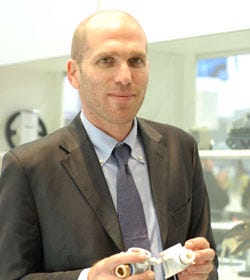How 3-D Printing Injection Molds Can Save You Time and Money
April 8, 2015
A growing number of device firms are using 3-D printing to produce injection molds.
Brian Buntz
|
Nadav Sella |
About five years ago, Nadav Sella, now director, manufacturing tools at Stratasys, spotted a company using 3-D printing to make injection molds. "I was very enthusiastic about the process and I started working to develop the technology," Sella says, who at that time was working at Object. (Stratasys and Objet would merge in 2012.)
Fast forward to present, and Stratasys now has dozens of customers across a range of industries using the process, mainly using thermoplastics and thermoplastic elastomers but also using engineering plastics. "Basically, we are seeing more and more interest in 3-D printing of injection molds," Sella says, who is speaking on the subject at MD&M East.
While the technique cannot completely replace traditional steel and aluminum molds for all applications, it is well suited to produce the first run of injection molded parts. The technique also can be used for short production runs of parts from the end product material. "It can be very helpful when you want to get your product into regulatory, sterilization, or functional tests," Sella explains.
Using standard plastics, the technique can be used to produce 50-100 parts. Using engineering plastics (up to 300 °C), 5-40 parts can be produced. Finally, with TPE, more than 100 parts can be made. (See the Stratasys Technical Application Guide for more details.)
Two of the primary advantages for this applications are cost and time savings. "If you could use the technique in the design process to make one mold per week and save $2000 per tool, that translates to a savings of more than $100,000 per year," he says. "The more complex the mold, the more significant the cost savings."
The design firm Worrell Design (Minneapolis), which is collaborating with Stratasys on 3-D printed injection molds, says the technique usually costs 70% less than traditional tooling production.
Another advantage for medical device companies is that it can be used to reduce the time to market. Worrell estimates that it takes approximately 96% less time than traditional tooling when used for small batch prototyping. Instead of taking six to eight weeks to produce tooling, it can be accomplished in a matter of days.
Diversified Plastics, a custom plastic injection molding company also based in Minneapolis, is also leveraging 3-D printing to make injection molds. After acquiring a Objet 260 Connex 3-D printer in 2014, the company used the system to print molds for a medical device client that had tight time-to-market requirements, as it explains in a YouTube video.
Stratasys has developed a material known as Digital ABS that combines high-temperature resistance and toughness that is well suited for the process. The material is heat-resistant and strong enough to stand up to short injection molding runs in the range of 10 to 100 parts.
"Digital ABS is a thermoset acrylic material that can be cured with UV light," Sella explains. "It is made out of two base components that are printed simultaneously." Digital ABS's name is a reference to the polarity of its ingredients: one of the materials used in the material features high heat resistance while the other offers toughness. "We can precisely control how the droplets of the two materials are 3-D printed. We can put them side by side and control each drop."
The infographic below from Worrell Design highlights the benefits of 3D IM.

Nadav Sella will be charing the 3-D printing track at BIOMEDevice Boston, May 6-7, 2015 and will be speaking at MD&M East, which is held June 9-11. |
Like what you're reading? Subscribe to our daily e-newsletter.
About the Author(s)
You May Also Like


.png?width=300&auto=webp&quality=80&disable=upscale)
